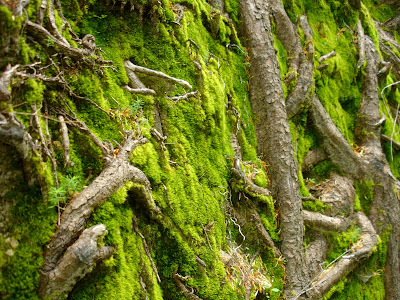
A rainy chilly morning once again dispelling any sense of summer. At least summer as I like to think of it, blistering hot, cucumber-laden, shade-seeking summer. At least the rain keeps the pools of fog out of the valley. I have a gothicky side that loves a blinding fog. But this time of year when the fogs start settling in it can mean death for our tomatoes. Already the chilly nights dipping into the 40’s--- for chrissake, it’s August!---has slowed the already sluggish ripening process.
I started to look for green tomato recipes, but the ever-optimistic Michael told me to “hold my horses”. His faith in a tomato-y future, a red ripe tomato-y future seems futile to me. But who am I to question faith? Or complain about a Northwest summer that is truly not that far from normal?
But you can’t eat 4-leafed clovers. Well, I guess you can. You might even be able to make some sort of pesto out of them. Hmmm.
Yet there is always one green thing that is ripe and ready. Cabbage. It’s no wonder they are a constant in Northern European cuisine. We had cabbage last year when summer was sweltering and we have cabbage this year when summer is faltering. Beyond my seasonal pinings for sauerkraut, I love the pallid sulfurous crunch cabbage lends to fish tacos, I even eat the slightly wilted and greasy bed of it that comes under the egg rolls in our favorite Vietnamese restaurant Tamarind Tree.
Cabbage is comfort food for me. Other people might like their loaf of bread, their potatoes, their 5 o’clock cocktail. For me it’s cabbage. Even before I was farming I always had a head of cabbage in the crisper. It’s exactly this storability which puts me at ease. We leave them in the field nearly until Christmas if we don’t get a frost. Or we hang them upside down roots and all in the basement, where they last until spring. Actually one started growing again to our amazement.
So when my flimsy faith in a red tomato-y future wanes I take precious comfort in our rows of cabbages, benign and beneficent. If there won’t be spaghetti sauce there will at least be potagers.
Yet, I can’t help but hopefully turn up the cucumber leaves in my search for supplies to fuel one of my greatest summer pleasures, pickling. This year I managed to squeeze out 4 quarts of pickles. Not a lot I know but come December, a guaranteed triumph over winter and grocery store prices.

I have been driving Michael crazy with my obsession with heirloom vegetables with Wisconsin place names. After the year we tried “Pride of Wisconsin’ cantaloupe and it barely made it to boasting, he’s been suspect. But his good nature and scientific inquisitiveness always lets me experiment.
So this year it was ‘Sheboygan’ paste tomatoes. Named after the foggy city on the shores of Lake Michigan I thought they might have a chance here. Actually they’ve proven to be the only tomatoes to ripen for us so far this year. Don’t forget we have a red tomato-y future ahead. They are a lovely pink and have a delightful sweet flesh. We will definitely grow this one again.

The cucumber ‘Wautoma’ named after the Central Wisconsin city famous for pickle production, Wisconsin ranks 4th in US pickle production, has not been extremely generous, how could it be with nights dipping in to the 40s. But the gherkins it did produce were, crispy and flavorful with a a dark green skin making a beautiful pickle.
Since I am off to Wisconsin tomorrow, I’m afraid I might miss that one red tomato which the future promises. Or the 3 cucumbers which are smaller than the slugs, granted we have very large slugs and a few too many this year, inching their way to completion. But I know I can take comfort in the fact that when we return in 2 weeks there will be cabbage. Not just one cabbage, but months worth of cabbage, ripe and green and ready for the picking.















